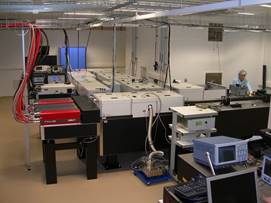
Managing the FAB1-10 laser on the ATTOLAB platform
Since 2016, the ATTOLab platform has combined the FAB1-10 laser, devices generating its femto/attosecond XUV pulses by high harmonic generation in gases, and experimental stations for ultrafast dynamics in gas and solid phases.
More specifically, the SLIC team is in charge of the FAB1-10 laser.
Based on the frequency-drift pulse amplification technique in Titanium-Sapphire, the FAB1-10 laser is designed to deliver ultra-short, CEP (Carrier Envelope Phase) stabilized pulses at 1 kHz and 10 kHz.

The architecture of the FAB1-10 laser is shown in the figure above. FAB1-10 comprises a front-end consisting of an oscillator, a stretcher and 3 preamplifier stages operating at 10 kHz.
The second and third preamplifier stages, regenerative and single-pass respectively, comprise two crystals in the original configuration co-developed by our team and Amplitude-Technologies (Golinelli et al., OPTICS LETTERS 42 (12), 2326 (2017).
The front-end feeds two cryogenically cooled multipass power amplifiers operating at 1 kHz (FAB1 channel) and 10 kHz (FAB10 channel) respectively.
Average power after compression is 15W for FAB1 and 20W for FAB10. The main performances obtained for the FAB1 and FAB10 channels are shown in the table below.
| Laser channel | Rep rate | Pulse duration | Energy/pulse | Energy stability (rms) | CEP stability (shot to shot) |
| FAB1 | 1 kHz | 24 fs | 15 mJ | 0,8% | |
| FAB10 | 10 kHz | 23 fs | 2 mJ | 1% |
The capabilities of the FAB1-10 laser have recently been enhanced by the development and installation at SE1 of a post-compression system based on a tensioned fiber, which routinely produces ultra-short pulses of 3.8 fs at an energy level of 2.5 mJ at 1 kHz. This device was used for a first experiment in 2022.


